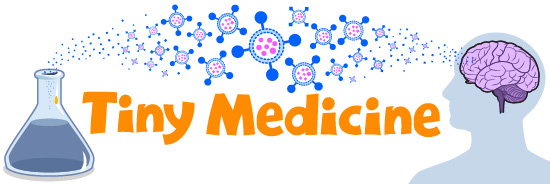Nanoparticles Stick
As nanoparticles search far and wide for the cells they want to target, they need to keep their trusty antibodies by their side. Otherwise they’d never be able to tell which cells to go to. But how do the antibodies know where to go when the nanoparticles don’t?
Well it isn’t magic. Antibodies are shaped just right so that they can fit a specific protein exactly, like two pieces of a puzzle, or a lock and key. Once scientists know which proteins are found only on the surface of the cell they want to target, it’s just a matter of making antibodies that fit them.
Antibody Parts and How they Work

Antibodies are made of four separate proteins: two heavy chain proteins and two light chain proteins. They are called chains because they are long, skinny, flexible proteins. The two light chains are stuck onto the heavy chains using a strong bond type called a disulfide bond.
The parts of the antibody that are blue in the picture are the same for every single antibody. This is important, because this is the part that sticks to the nanoparticle. If the nanoparticles bind to this part that never changes, then they don’t have to be limited to the kinds of antibodies they can have.
Antibodies also have parts at the ends, shown in purple, that are different for each antibody. These are the parts that can recognize and bind to a specific protein. Immune cells can produce around a million different protein binding sites on the antibodies they make. Each cell makes a different antibody, and when finds a foreign protein that its antibodies bind to, it will start making tons more.
Read more about: Latch and Catch
Bibliographic details:
- Article: Nanoparticles Stick
- Author(s): Dr. Biology
- Publisher: Arizona State University School of Life Sciences Ask A Biologist
- Site name: ASU - Ask A Biologist
- Date published: 25 Nov, 2015
- Date accessed:
- Link: https://askabiologist.asu.edu/what-makes-nanoparticles-sticky
APA Style
Dr. Biology. (Wed, 11/25/2015 - 09:11). Nanoparticles Stick. ASU - Ask A Biologist. Retrieved from https://askabiologist.asu.edu/what-makes-nanoparticles-sticky
Chicago Manual of Style
Dr. Biology. "Nanoparticles Stick". ASU - Ask A Biologist. 25 Nov 2015. https://askabiologist.asu.edu/what-makes-nanoparticles-sticky
Dr. Biology. "Nanoparticles Stick". ASU - Ask A Biologist. 25 Nov 2015. ASU - Ask A Biologist, Web. https://askabiologist.asu.edu/what-makes-nanoparticles-sticky
MLA 2017 Style

Be Part of
Ask A Biologist
By volunteering, or simply sending us feedback on the site. Scientists, teachers, writers, illustrators, and translators are all important to the program. If you are interested in helping with the website we have a Volunteers page to get the process started.

